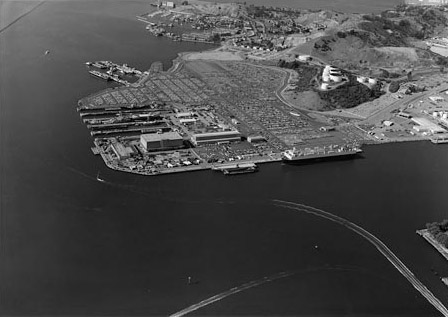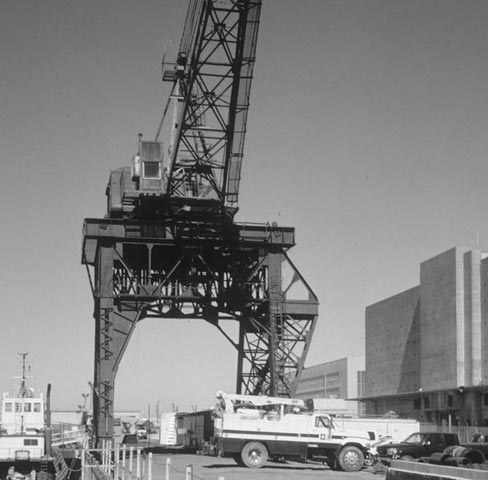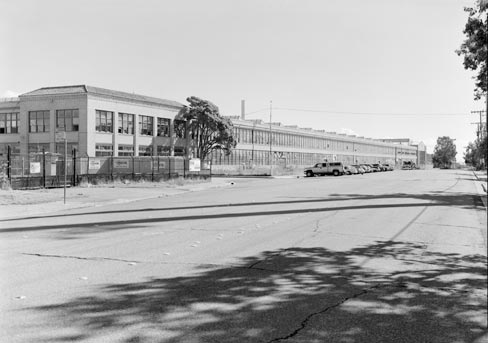Article
Authenticity and the Preservation of Technological Systems(1)
by Fredric L. Quivik
Over the past several decades, the historic preservation community has shown increased interest in preserving technological and engineering sites. Extensive statewide historic bridge surveys aimed at saving significant structures have been completed as states and the U.S. Government plan for the expansion and improvement of transportation systems. Historic factories and warehouses have acquired new uses as residential and commercial complexes. Important industrial landscapes have been preserved. Such efforts also aim to preserve important artifacts such as the equipment associated with the buildings and other structures. Now more than ever, understanding the large-scale technological systems in which the artifacts and sites played a role is critical to preserving their authenticity and interpreting them fully and accurately to the public.
Technological Systems
The study of the history of technology has expanded far beyond individual inventions or engineering designs, such as the cotton gin or the suspension bridge, since the coalescence of the discipline in the 1980s. Most historians of technology now recognize the importance of entire systems in understanding the development and evolution of modern technology. Thomas Parke Hughes's book, Networks of Power, was seminal in this regard.(2) In it, Hughes showed that the incandescent light bulb would have been useless had its inventor, Thomas Edison, not also developed a technological system of generators and other component parts, a distribution network, and a customer base to support and use it.
In the 20th century, technological systems grew even larger and more complex, and system builders in the United States became especially adept at developing, analyzing, and managing them. Although it may be easy to preserve a component of an historic system, it is difficult to preserve an entire system. If a component loses some significance in the absence of its system, how can a preserved component communicate authenticity in relation to its larger system?
In 2000, Tom Leary and Libby Sholes articulated a number of concerns about authenticity in an industrial preservation context.(3) Chief among them were concerns for an authenticity that places an industrial artifact in its social and economic context and for "recovering industrial experiences" out of which those artifacts arose. Such concerns have led curators and interpreters to focus on such things as workplace environments and relationships of mutual support among co-workers and authority within industrial hierarchies. Professionals have urged museums and historic preservation professionals to set aside traditional approaches to the presentation and interpretation of industrial heritage. As a consequence, the relevance of preserved artifacts and sites to the local community often gets the most attention to the detriment of the larger systems in which those artifacts and sites played a part. Good interpretation may also include components that link the local to the national or global context through supply networks or marketing, much as a natural history museum might explain how a particular plant, animal, or site is part of a larger ecosystem. No single entity controls those larger systems.
This essay considers systems in which the parts are not only interrelated but also controlled or managed by a single entity. A technological system, as Hughes defines it, has parts, components, and networks that are under the control of the manager of the system.(4) There are likely also components or networks on which the technological system depends that are beyond the control of the system manager. Hughes called attention to the ways system builders brought ever more of those components and networks into the expanding embrace of their technological systems.
The very idea that such complex, large-scale technological systems could be managed entered the public consciousness after World War II with the advent of the Atlas and Polaris missile programs in the United States, the celebrated effort by the National Aeronautics and Space Administration (NASA) to put a man on the moon, the emergence of think tanks like the RAND Corporation that were organized to perform complex systems analyses, the use of computers in support of those projects and programs, and the widespread application of a systems approach to solving social problems by businesses and all levels of government.(5)
Earlier in the 20th century, complex technological systems were typically developed within the context of the business firm.(6) During the 1930s and 1940s, corporate and government system builders extended the embrace of technological systems beyond the boundaries of the firm. The scientists, engineers, and management specialists who devised the techniques for designing and managing such large and complex projects like Atlas and Polaris acquired critical experience during World War II. The Manhattan Project developed and built the atomic bomb in an amazingly short period of time, yet the seeds of the systems approach actually sprouted in the wartime effort to coordinate the procurement, production, shipment, and distribution of an unprecedented volume of ordnance and other military supplies and to build the facilities to accommodate those interrelated tasks. Participants in the ordnance production programs in the United States in turn credited their successes to their experiences working on the large federal dam construction projects of the 1930s, which involved several companies all working towards a common, ambitious goal.(7)
Looking at a large industrial object, cultural resource professionals may be tempted to limit their attention to the object's own mechanics and the skills necessary to operate it. What can the professionals do to ensure that they are presenting an authentic picture of that object's place in its technological system? When looking at an industrial building owned and operated by a company, it might seem reasonable to limit the scope of the research to the corporate biography of that particular company. What can be done to ensure an authentic interpretation of that company's place within the larger technological system that may have been controlled by some distant system manager?
Challenges to Authenticity
The new Rosie the Riveter/World War II Home Front National Historical Park in Richmond, California, established by Congress in 2000 and under development by the National Park Service, raises important questions about authenticity and the preservation of technological systems.(8)(Figure 1) Those questions touch upon aspects of the sites that are essential to understanding them, from their physical scale (both then and now), to their role in global technological systems, to the central role of a single part—in this case a whirley crane—in accomplishing one of the key elements of the astounding wartime mass production method employed in Richmond and elsewhere in the United States.
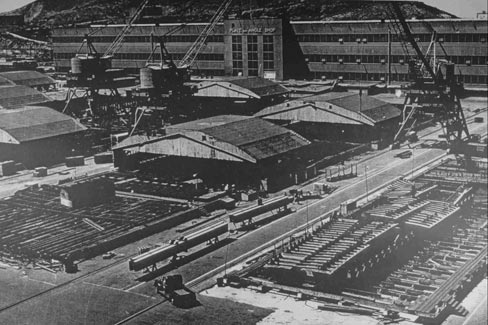 |
Figure 1. Kaiser's Richmond Shipyards maximized the pre-assembly process to build ships for the U.S. Maritime Commission during World War II. (Courtesy of the author.) |
The National Park Service favored this location on San Francisco Bay for a new park because Richmond was drastically altered by wartime mobilization and retains significant physical resources that embody many facets of the community's and the nation's mobilization and homefront experiences. Primary among those resources are the Ford Motor Company's Richmond assembly plant and Richmond shipyard no. 3, the last remaining yard of the four giant shipyards built and operated on the Richmond waterfront by Henry J. Kaiser's organization for the U.S. Maritime Commission.(Figures 2 and 3) The Kaiser shipyards produced Liberty ships, troop ships, and other ocean-going vessels needed by the U.S. and its allies to fight the Axis powers in the European and Pacific theaters of the war. The home-front experience marked a threshold in U.S. history for women, African Americans, and many others who gained their first entry into the nation's industrial workplaces. Many of them and their families still live in or near Richmond.
Scale
The U.S. mobilized its industrial infrastructure during wartime by converting existing industrial plants to production for the war effort and by building new industrial facilities. The two big industrial facilities at Richmond represent each of these endeavors. The Ford plant was 10 years old when the U.S. entered the war, and the plant was converted to assemble and process military vehicles. The Richmond shipyards emerged mostly from mud flats on the city's waterfront where, in less than two years, Kaiser built shipbuilding facilities that would employ nearly 100,000 workers and build 747 ocean-going ships during the war.
Today, the two sites and their surviving resources pose major challenges to the authentic interpretation of scale. The Ford plant presents itself as an impressive industrial structure.(Figure 4) It covers eight acres under its roof, but it employed fewer than 3,000 workers both before and during the war. On the other hand, shipyard no. 3 employed 26,000 workers at its peak in 1943.(9) Yet the surviving basins and buildings at shipyard no. 3 suggest a considerably smaller operation than the Ford plant. The absence of an imposing sense of scale is due to several factors: the loss of the plate shop, which gave spatial meaning to the large open area north of the basins, where most of the pre-assembly work for yard no. 3 took place; the absence of ships and scaffolding in the basins, where the ships were actually erected; and the absence of the array of whirley cranes that functionally integrated the plate shop, the pre-assembly area, and the basins where hulls were erected.(10)
Parts versus the Whole: The Role of a Large Local Complex
in a Global Technological System
The Ford plant presents a second obstacle to interpreting and understanding scale. Its impressive size suggests that it was a complete facility for the manufacture of automobiles or military vehicles. As a stand-alone plant, however, the Ford plant was functionally useless. It was merely one component of the Ford Motor Company's global system of processing raw materials into industrial materials, manufacturing car parts out of those materials, shipping parts to assembly plants located throughout the U.S. and abroad, and assembling those parts into finished vehicles for delivery to regional markets.
Built in 1931, Ford's Richmond plant served an integral function in the large Ford system until the nation's full-scale industrial mobilization for the war. At that time, the Richmond plant became one unit in a much larger and more complex system that spanned corporate boundaries and fell under the control of an alphabet soup of federal war production agencies, most directly the U.S. Army's Ordnance Department. During the war, the Richmond plant, renamed the Richmond Tank Depot, had two functions: to assemble jeeps and process tanks and other combat vehicles before they were shipped off to war. In assembling jeeps, the Richmond plant worked much as it had before the war, only now it was taking delivery of some parts made by other companies. In processing tanks, the Richmond Tank Depot played a crucial role in the Ordnance Department's scheme for manufacturing thousands of combat vehicles and delivering them to U.S. and Allied forces overseas.
During the war, several companies and factories built combat vehicles. The Ordnance Department's original plan called for each company to complete its contracted number of combat vehicles so that they were all fully outfitted with armaments and communications equipment and ready for battle. Due to delays in the delivery of some components from suppliers, factories began stockpiling large numbers of unfinished vehicles on their lots. When the lots filled up, the on-going assembly of more vehicles slowed down or stopped completely, lowering the morale among workers who were trying to maximize production for the war effort.(11) The Ordnance Department addressed the logjam by establishing several tank depots around the country, each with ample capacity to stockpile vehicles, which meant that each factory could immediately ship fully-assembled but incompletely outfitted combat vehicles as soon as they came off the line. The tank depots received the assembled vehicles, supplies for final outfitting, orders for each vehicle's final destination, and then outfitted and prepared each vehicle for shipment. The Richmond Tank Depot was one such facility.(12)
The additional organizational layer of the tank depots might seem like a subtle modification in the system, but Ordnance Department accounts indicate that it greatly increased the speed at which the nation's mobilized industry was able to manufacture combat vehicles and deliver them to the front. But, how important is this nuanced role to the authentic interpretation of the Rosies and the World War II home front experience? Alternatively, how will the personal and local experiences of the Rosies and the men who worked at the Richmond site influence the interpretation of the vast technological systems in which the plant and, later, the depot played supporting roles?
Parts versus the Whole: Whirley Cranes and Large-Scale Mass Production
The whirley crane at Rosie the Riveter/World War II Home Front National Historical Park is of the type that virtually all of the World War II shipyards used for moving heavy objects during the production process. The crane squarely fits John Bowditch's criteria for selecting one or more large industrial objects to collect for preservation and interpretation at a museum: It is instantly recognizable for what it is; it will draw visitors' attention; and it represents the scale of the process employed at the Richmond shipyards.(13) Or does it? It depends on whether a single whirley crane can authentically represent the scale and complexity of the system employed at shipyard no. 3 and other World War II emergency shipyards.
In the years leading up to World War II, the U.S. Maritime Commission began contracting with companies to build shipyards for the mass production of merchant ships. These companies exploited several advanced methods, most notably welding of hulls instead of riveting, pre-assembly of large hull sections at locations other than the shipways or graving basins, and the design of shipyards for the efficient mass production of a single model of ship rather than an assortment of ships. These methods in turn enabled shipyards to hire minimally or unskilled workers whom they then trained in a limited array of specialized tasks. Henry Kaiser's company did not have experience building ships, but it did have experience with big government contracts for the construction of dams during the New Deal. The Maritime Commission signed contracts with a variety of companies, some old-line shipbuilders and some without shipbuilding experience, like Kaiser, to construct emergency shipyards on the East, Gulf, and Pacific Coasts.(14)
One of Kaiser's first contracts was for a new shipyard at Richmond to build 30 new merchant ships for Great Britain. In December 1940, the Kaiser organization began assembling a team of managers and engineers from the Grand Coulee Dam and other projects to design the new Richmond shipyard and supervise its construction. The next month, the U.S. Maritime Commission accelerated its emergency shipbuilding program with plans for many new yards dedicated to building a "Liberty Fleet." The new wave of contracts included one to Kaiser for a second yard at Richmond (shipyard no. 2). Eventually, Kaiser contracted with the Maritime Commission to build two more yards at Richmond, one for the production of troop ships (shipyard no. 3), and the other for the production of landing ships, or LSTs (shipyard no. 4).(15) Each of the four shipyards had a strategy for pre-assembly of large components away from the shipways or basins and its own array of large cranes for moving the heavy and bulky pre-assembled components into position.
One of the significant differences between yard no. 3 and the other Richmond yards was that the platens, or pre-assembly platforms at the heads of the basins, were much longer, with nearly twice the distance (about 500 feet) between the plate shop and the basins than at the other yards. The larger area allowed more pre-assembly activities to take place on the assembly platforms, which was especially important in the construction of C-4 troop ships.(16) The plate shop sat at the north end of the pre-assembly area and housed equipment for cutting and shaping steel plates for use on the assembly platforms, where teams of welders and other workers pre-assembled the large pieces of steel into hull and deck components. North and west of the plate shop were large open areas for steel storage.(17) Because the plate shop is now gone, the large pre-assembly and storage areas lack spatial definition. In fact, the impressive Art Moderne warehouse that graces yard no. 3 now seems to be the facility's most important structure even though it served a function that was by no means unique to shipbuilding or integral to pre-assembly.
Erection of a C-4 troop ship at yard no. 3 followed a routine sequence. Workers first laid the keel plates on supports along the bottom of a basin. At the same time, riggers erected the scaffolding around the perimeter of the basin. Then, crews attached bottom shell panels and the stern frame to the keel plates. Next, whirley cranes hoisted pre-assembled double-bottom units and lower portions of the fore and aft peak units into position, and the components were welded into place. From that point onward, the hull began to take shape with the placement of pre-assembled shell panels. Meanwhile, whirleys lowered internal components into position, including pre-assembled decks, foundations for the machinery of the propulsion system, the engine room and the propulsion system, and tanks and a distiller for the potable water system. After the upper deck was placed and welded into position, on-deck equipment and then pre-assembled components of the deck houses and the superstructure decks were hoisted into place. Finally, items like masts, the stack, and gun tubs were lifted into position. As the hull neared completion, crews disassembled the scaffolding and then filled the basin with water. Once the ship was afloat in the basin, the gates to the basin were removed and the yard was readied for the launching ceremony, after which a tug towed the ship out of the basin to one of the outfitting docks.(18)
When yard no. 3 was fully operational, the basins had 12 whirley cranes, 8 of which had 60-ton capacities; the outfitting dock had 4 whirley cranes, and the plate storage area had 3. In addition, the yard had 15 truck-mounted cranes for moving materials and machinery about the yard. The plate shop had 13 traveling bridge cranes and 19 jib cranes.(19)
The crane operators are said to have had one of the most envied jobs in the shipyards. Operating engineers had to have two to four years of experience with smaller equipment before they could begin to practice on whirley cranes, and then only under close supervision. Crane operators sat in the cabs of whirley cranes and operated them, but they could not do their work without the riggers who worked with the loads on the ground. These key shipyard workers estimated how much the loads weighed; worked with the chain, cable, and rope used in hoisting loads; attached and unattached slings to the loads; used hooks and other devices to secure cables to loads; and signaled to the crane operators the kinds of crane and load movements that were required.(20)
Because every yard had so many whirley cranes, they formed the striking visual character of the Richmond shipyards' skylines. Whirleys were of such note in the Richmond yards that the character Shirley the Whirley appeared occasionally in the Kaiser company's weekly Richmond periodical, Fore'n'Aft.(21)(Figure 5) According to a 1943 article, "Whirley crane work is the most spectacular in the shipyards and always is one of the things visitors find most fascinating to watch, especially when two cranes get together for a big double lift."(22)
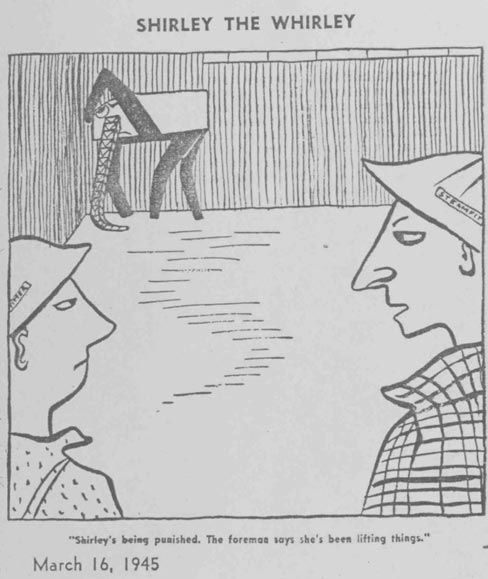 |
Figure 5. This Shirley the Whirley cartoon character appeared in the March 16, 1945, and other issues of the Richmond Shipyard newsletter, Fore’n’Aft. (Courtesy of the author.) |
Pre-assembly was key to the rapid mass production of ships during World War II. Whirley cranes provided the means to exploit all that the pre-assembly process offered in terms of speed of production, productivity of labor, and efficient land-use by moving large and heavy pre-assembled components from the platens to the shipways or basins. Often, teams of cranes worked together to lift, flip, and transport pre-assembled units. A single crane, in the absence of the plate shop, which helped give meaning to the large, open pre-assembly area, and in the absence of other whirley cranes, which worked in teams to lift the large pre-assembled components into position, is unlikely to give visitors a genuine impression of the complexity of the shipbuilding operation.
Conclusion
Although a great addition to Richmond shipyard no. 3, one crane by itself will fall short of conveying an authentic sense of the scale and complexity of what Kaiser and the Richmond shipyard workers accomplished during World War II. The Ford plant is a huge building—so huge that visitors may assume it was a free-standing site of production during the war. The challenge in interpreting the Ford plant authentically ultimately lies in conveying the integral role the plant played in the Ordnance Department's global technological system for manufacturing and delivering combat vehicles. Today, the Ford plant dwarfs Richmond shipyard no. 3, but during the war, and taking into account the shipyard's workforce and operations, the situation was the reverse.
About the Author
Fredric L. Quivik is a Philadelphia-based consultant, historian of technology, and a frequent expert witness in U.S. court cases pertaining to the Comprehensive Environmental Response, Compensation, and Liability Act of 1980 (commonly known as the Superfund law).
Notes
1. This essay is based on a paper, "The Question of Authenticity When Applied to the Preservation of Components of Complex, Large-Scale Technological Systems," presented at the Fifth National Forum on Historic Preservation Practice, "A Critical Look at Authenticity and Historic Preservation," March 23-25, 2006, at Goucher College, Baltimore, Maryland.
2. Thomas P. Hughes, Networks of Power: Electrification in Western Society, 1880-1930 (Baltimore, MD: Johns Hopkins University Press, 1983).
3. Thomas E. Leary and Elizabeth C. Sholes, "Authenticity of Place and Voice: Examples of Industrial Heritage Preservation and Interpretation in the U.S. and Europe," The Public Historian 22 (Summer 2000): 49-66.
4. Hughes, Networks of Power, 5-6.
5. On the application of the systems approach (systems engineering, systems management, systems analysis, etc.) to military and aerospace projects, see Thomas P. Hughes, Rescuing Prometheus (New York, NY: Pantheon, 1998); and Agatha C. Hughes and Thomas P. Hughes, eds., Systems, Experts, and Computers: The Systems Approach in Management and Engineering, World War II and After (Cambridge, MA: MIT Press, 2000). On the application of the systems approach to social problems, see Marvin Berkowitz, The Conversion of Military-Oriented Research and Development to Civilian Uses (New York, NY: Praeger, 1970); and Robert H. Haveman, Poverty Policy and Poverty Research: The Great Society and the Social Sciences (Madison: University of Wisconsin Press, 1987).
Several historians have explored the history of the development of corporate systematic approaches to the design and management of large-scale technological systems in the 19th and early 20th centuries. See, in addition to Hughes's Networks of Power, James R. Beniger, The Control Revolution: Technological and Economic Origins of the Information Society (Cambridge, MA: Harvard University Press, 1986); Alfred D. Chandler Jr., The Visible Hand: The Management Revolution in American Business (Cambridge, MA: Belknap Press, Harvard University Press, 1977); and David A. Hounshell, From the American System to Mass Production, 1800-1932: The Development of Manufacturing Technology in the United States (Baltimore, MD: Johns Hopkins University Press, 1984).
6. Several historians have explored the history of the development of corporate systematic approaches to the design and management of large-scale technological systems in the 19th and early 20th centuries. See, in addition to Hughes' Networks of Power, James R. Beniger, The Control Revolution: Technological and Economic Origins of the Information Society (Cambridge, MA: Harvard University Press, 1986); Alfred D. Chandler Jr., The Visible Hand: The Management Revolution in American Business (Cambridge, MA: Belknap Press, Harvard University Press, 1977); and David A. Hounshell, From the American System to Mass Production, 1800-1932: The Development of Manufacturing Technology in the United States (Baltimore, MD: Johns Hopkins University Press, 1984).
7. Allen Schick, "The Road to PPB: The States of Budget Reform," Public Administration 26 (December 1966): 243-258; Dean S. Warren, "Human vs. Hardware—A Critical Look at Aerospace as an Urban Problem Solver," Aviation Week & Space Technology 94 (June 7, 1971): 62; John E. Bokel and Rolf Clark, "Acquisition in World War II," in The Big L: American Logistics in World War II, Alan Gropman, ed. (Washington, DC: National Defense University Press, 1997), 102.
8. The author researched and wrote histories of both the Ford Motor Company's Richmond assembly plant and Kaiser's Richmond shipyard no. 3 for the Historic American Engineering Record (HAER) in support of the NPS's Rosie the Riveter development. The author's thoughts on authenticity at Rosie the Riveter are his own and do not represent the views or opinions of the National Park Service. Fredric L. Quivik, "Ford Assembly Plant," HAER No. CA-326-H (Washington, DC: National Park Service, 2003); Quivik, "Richmond Shipyard No. 3," HAER No. CA-326-M (Washington, DC: National Park Service, 2004). See http://memory.loc.gov/ammem/collections/habs_haer/index.html for the HAER documentation produced as part of the recording project.
9. "Richmond Tank Depot, Vol. I, 1 January to 30 September 1944," RG 156, Records of the San Francisco Ordnance District, National Archives and Records Administration (hereafter cited as NARA), San Bruno, CA; "Total Payroll & Percent Women on Payroll [as of last day of month]," a collection of unpublished graphs in folder 1, box 289, Henry J. Kaiser Records (hereafter cited as HJK 83/42c), manuscript collection 83/42c, Bancroft Library, University of California at Berkeley.
10. Quivik, "Richmond Shipyard No. 3."
11. Complicating the matter, the Army did not always know the final destination of each tank as it came off the line, which further delayed the outfitting of vehicles.
12. Quivik, "Ford Assembly Plant."
13. John Bowditch, "The Big, the Bad, and the Ugly: Collecting Industrial Artifacts for History Museums," Pittsburgh History 72 (Summer 1989): 91-92.
14. On the development of the Kaiser shipbuilding organization and its relationships to the U.S. Maritime Commission, Todd Shipyards Corporation, and Bechtel and the other six companies, see Frederic C. Lane et. al., Ships for Victory: A History of Shipbuilding Under the U.S. Maritime Commission in World War II (1951; Baltimore, MD: Johns Hopkins University Press, 2001), 53-54, 138-146, 220-222 "Biggest Splash," Fortune 24 (July 1941): 47, 121-122, 124, 126, 128, 130; "The Earth Movers," three-part series in Fortune 28 (August 1943): 99-107, 210, 212, 214, (September 1943): 119-123, 219-220, 222, 225-226, and (October 1943): 139-144, 193-194, 196, 199.
15. LSTs are landing ships capable of delivering tanks to beachheads.
16. Because they had to accommodate people and not bulk cargo, the C-4s had many more bulkheads below decks, which meant they had many more pieces of steel that could be pre-assembled.
17. "Richmond Yard No. 3, General Yard Plan," n.d., in D.D. Dick, "Shipyard Facilities Index: West Coast Yards," unpublished report dated July 1, 1945, RG 178, NARA, College Park, MD; Kaiser Company, Inc., "Proposed Extensions to Craneways," drawing no. C4-M-98, dated May 28, 1943, in the collection of Donald L. Hardison, El Cerrito, CA (hereafter cited as DLH); Kaiser Company, Inc., "Shell To Shell Assembly Units," drawing nos. C4-M-133 and C4-M-134, dated June 15, 1943, in DLH; "Chronological History of Kaiser Company, Inc., Shipyard Number Three," 3-4, unpublished, undated report in file 1, box 289, HJK 83/42c; Lane, Ships for Victory, 220-222.
18. The erection sequence for a C-4 hull is depicted in a series of 31 Kaiser Company, Inc., drawings, nos. ES-C4-0-1 through ES-C4-0-31, dating from August 26, 1942, through May 7, 1943, in DLH. Sequential photographs of a C-4 taking shape at yard no. 3 appear in Kaiser Company, Inc., Hull 50 (Richmond, CA: Kaiser Company, Inc., 1945), commemorative book, DLH.
19. "Richmond Shipyard No. 3, Schedule of Shipyard Facilities as of July 1, 1944," unpublished report in "West Coast Yards, Shipyards Facilities Index," RG 178, NARA.
20. "Richmond Weight Lifters," Fore'n'Aft 3 (January 8, 1943): 2-3; Commonwealth of Pennsylvania, Department of Public Instruction, Division of Industrial Education, Shipyard Rigging: A Manual of Instruction for Beginning and Advance Training (Harrisburg: Commonwealth of Pennsylvania, Department of Public Instruction, 1943), 2-3; "Diagram for Shipping Deck House Section with One Crane," drawing dated May 9, 1942, and "Perspective Drawing of Inner Bottom Lifting Tackle," both in RG 178, Photo Album series, NARA.
21. "Shirley the Whirley," cartoon, Fore'n'Aft 5 (March 16, 1945): 3.
22. "Richmond Weight Lifters," 2.

